Standard [CURRENT]
ASTM E 1194:2025
Standard Test Method for Vapor Pressure
- Publication date
- 2025
- Original language
- English
- Pages
- 6
- Publication date
- 2025
- Original language
- English
- Pages
- 6
- DOI
- https://dx.doi.org/10.1520/E1194-25
Product information on this site:
Quick delivery via download or delivery service
Buy securely with a credit card or pay upon receipt of invoice
All transactions are encrypted
Short description
1.1 This test method describes procedures for measuring the vapor pressure of pure liquid or solid compounds. No single technique is able to measure vapor pressures from 1 × 10−11 to 100 kPa (approximately 10−10 to 760 torr). The subject of this standard is gas saturation which is capable of measuring vapor pressures from 1 × 10-11 to 1 kPa (approximately 10-10 to 10 torr). Other methods, such as isoteniscope and differential scanning calorimetry (DSC) are suitable for measuring vapor pressures above 0.1 kPa An isoteniscope (standard) procedure for measuring vapor pressures of liquids from 1 × 10−1 to 100 kPa (approximately 1 to 760 torr) is available in Test Method D2879 . A DSC (standard) procedure for measuring vapor pressures from 2 × 10−1 to 100 kPa (approximately 1 to 760 torr) is available in Test Method E1782 . A gas-saturation procedure for measuring vapor pressures from 1 × 10−11 to 1 kPa (approximately 10−10 to 10 torr) is presented in this test method. All procedures are subjects of U.S. Environmental Protection Agency Test Guidelines. 1.2 The gas saturation method is very useful for providing vapor pressure data at normal environmental temperatures (-40 °C to +60 °C). At least three temperature values should be studied to allow definition of a vapor pressure-temperature correlation. Values determined should be based on temperature selections such that a measurement is made at 25°C (as recommended by IUPAC) ( 1 ) , 2 a value can be interpolated for 25 °C, or a value can be reliably extrapolated for 25 °C. Extrapolation to 25 °C should be avoided if the temperature range tested includes a value at which a phase change occurs. Extrapolation to 25 °C over a range larger than 10 °C should also be avoided. If possible, the temperatures investigated should be above and below 25 °C to avoid extrapolation altogether. The gas saturation method was selected because of its extended range, simplicity, and general applicability ( 2 ). Examples of results produced by the gas-saturation procedure during an interlaboratory evaluation are given in Table 1 . These data have been taken from Reference ( 3 ). 1.3 The values stated in SI units are to be regarded as standard. No other units of measurement are included in this standard. 1.4 This standard is arranged as follows: Section Scope 1 Referenced Documents 2 Terminology 3 Summary of Test Method 4 Significance and Use 5 Reagents and Materials 6 Gas Saturation Procedure 7 Alternative Procedures 8 Calculation 9 Report 10 Precision and Bias 11 Keywords 12 1.5 This standard does not purport to address all of the safety concerns, if any, associated with its use. It is the responsibility of the user of this standard to establish appropriate safety, health, and environmental practices and determine the applicability of regulatory limitations prior to use. 1.6 This international standard was developed in accordance with internationally recognized principles on standardization established in the Decision on Principles for the Development of International Standards, Guides and Recommendations issued by the World Trade Organization Technical Barriers to Trade (TBT) Committee.
ICS
17.100
DOI
https://dx.doi.org/10.1520/E1194-25
Also available in
Loading recommended items...
Loading recommended items...
Loading recommended items...

